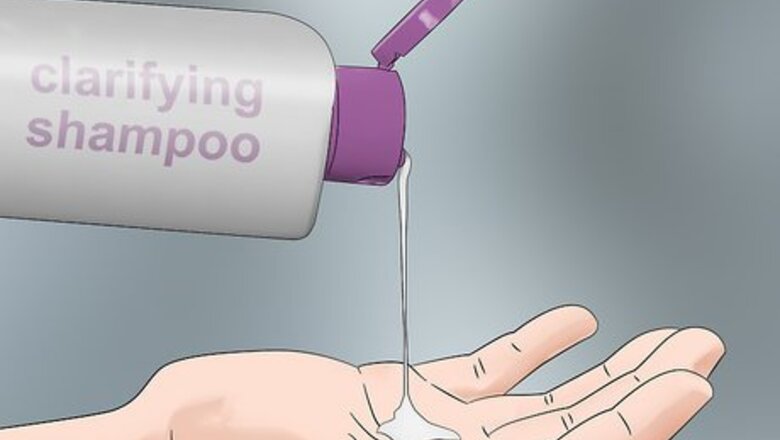
views
Using Specialized Products
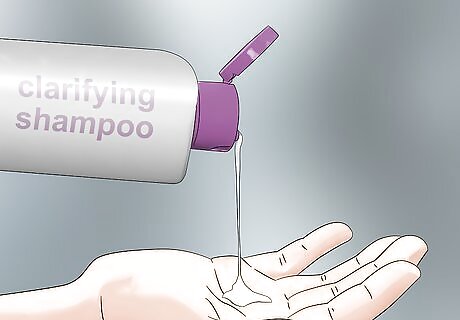
Use a mineral-removal or clarifying shampoo. Some shampoos are designed to remove minerals and pollutants from the hair. They are more expensive than regular shampoos, but are also typically meant to be used less frequently (just once weekly, in many cases). Mineral-removal shampoos work the same way that regular shampoos do. That is, wet your hair, then apply a dollop of shampoo to your hair. Work it into a lather, then rinse it out with water.

Try a chelating shampoo. A chelating shampoo contains the ingredient ethylenediamine tetra-acetic acid (EDTA), acetic acid, or citric acid. These shampoos bind with the iron particles and remove them when rinsed. Like clarifying shampoos, chelating shampoos can be harsh on the hair. Check the use label for recommended usage, and follow up with a conditioner to restore moisture to your hair. Chelating shampoos are available from most beauty supply stores or salons. Look for key words like “chelating” or “contains EDTA” when shopping for a chelating shampoo.
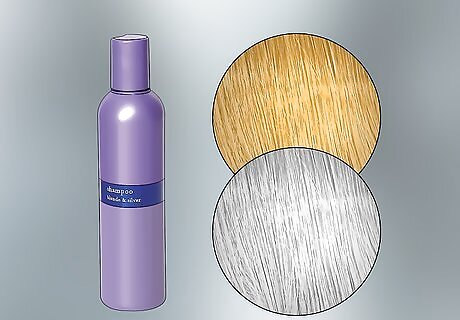
Use a purple shampoo meant for platinum blonde and gray hair. These shampoos have a temporary color in them that will neutralize red tones. Combine a dollop of this shampoo with a tablespoon of baking soda and work it into your hair. Wait 10 minutes, then rinse it out. The baking soda will help remove any rust or iron already in your hair.
Removing Rust With Household Items

Use lemon juice on your hair. Lemon juice is mildly acidic, which makes it perfect for getting rid of rust in your hair. Pour the lemon juice over your head and work it through your hair. Wait 10 minutes, then rinse your hair with warm water. Use lemon juice once weekly to combat rust in your hair. The volume of juice necessary for this treatment to be effective depends on the amount of rust in your hair. Apply enough lemon juice that all the areas of your hair are well coated with it. Lemon juice can be very drying, so make sure to use a moisturizing conditioner or hair mask immediately after finishing this treatment.
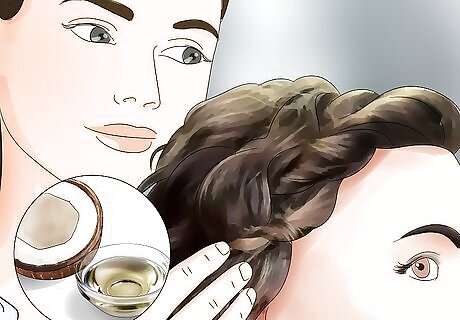
Work warm coconut or olive oil into your hair. Warm the oil of your choice for several seconds in the microwave or on the stove. Work the oil into your scalp and hair, and massage it for about 30 minutes. Rinse your hair afterward to wash it out. Because the oil must be continuously massaged into the scalp for 30 minutes, you might want to enlist a friend to help you. The oil will soften the rust buildup in your hair. If you wish, you could wrap your head in a warm towel after applying the oil. This will help your pores open up, increasing the amount of rust you’ll be able to get rid of using the oil application. You could also put a shower cap over your hair and sit under a hooded dryer. This will work much the same way as wrapping your hair in a warm towel.
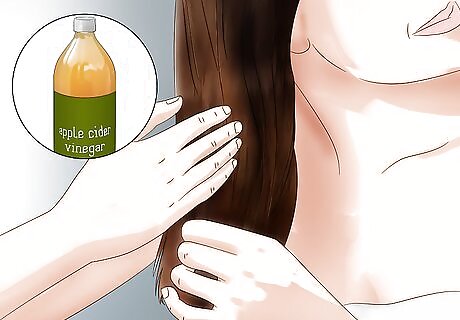
Wash your hair with apple cider vinegar. This common pantry item works wonders for removing rusty buildup in your hair. You can use it either on its own or after washing with your regular shampoo. Pour the apple cider vinegar on your hair as close as possible to your scalp. Rub it into your scalp and hair with your hands. After applying the vinegar, rinse your hair out with cold water to seal the cuticle. Your hair may smell faintly like vinegar after this treatment. Try using a leave-in conditioner to counteract the smell. You could use white vinegar instead of apple cider vinegar.

Make a paste of vinegar and cream of tartar. Mix equal parts vinegar and cream of tartar. For instance, you might mix eight tablespoons of each together. Slather the mixture over your hair and wait 10 minutes. After the time has elapsed, rinse it out with cool water.
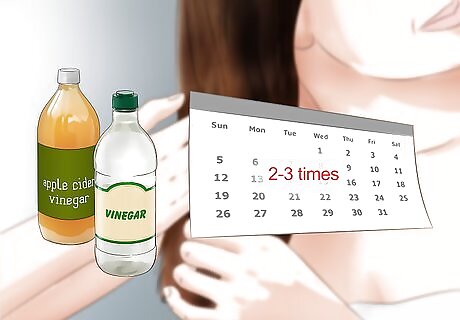
Don’t use vinegar on your hair more than two or three times per month. Vinegar can dry your hair out, so you should only use it sparingly. After using vinegar, use a conditioner to return some moisture to your hair. If you’re particularly sensitive to the drying effects of vinegar, you could try a milder application by mixing equal parts vinegar and distilled water. This could then be used directly or mixed into a cream of tartar solution.
Adjusting Water Usage

Install a water filter in your home. There are two types of water filters that could help you get rid of rust in your hair. One type requires you to remove your old shower head and replace it with a new one equipped with a built-in filter. The other type (known as whole house filters) connects to your home’s water tank. If you don’t own your own home (and therefore don’t have access to your water tank), a shower-based water filter is your best option. There are a wide variety of both kinds of filters. Specific directions for installation and use will vary depending on the product you buy. Consult manufacturer directions for more information. Check the filter you’re interested in to ensure it blocks or traps iron.
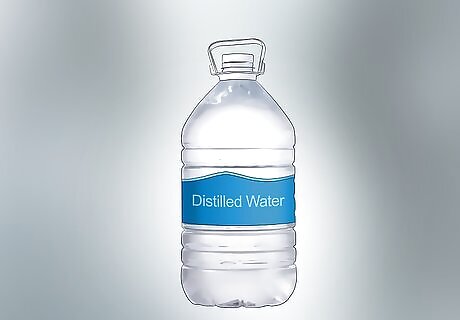
Use distilled water to wash your hair. While you can continue using your regular shower water to bathe, switch to bottled water to wash your hair. While in the shower, pour a large bowl of distilled water over your head to wet your hair. Apply your shampoo and work it into a lather. When you’re ready to rinse your hair, pour another large bowl filled with distilled water over your head. Instead of transferring it to a bowl, you could pour the water directly from a jug. Keep a jug of distilled water with a replaceable cap in your shower or bathroom.

Wash your hair using cooler water temperatures. Cooler water temperatures will minimize the amount of iron that settles in your hair. Use warm and hot water to wash your body, then turn the water temperature down when washing and rinsing your hair.
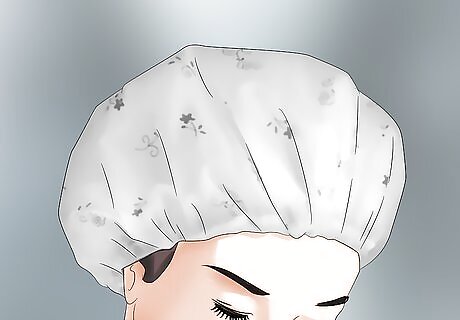
Keep your hair dry when bathing. Don’t wet your hair unless you need to wash it. Wear a shower cap to prevent your hair from getting wet, or just keep your hair out of the water’s path when in the shower.
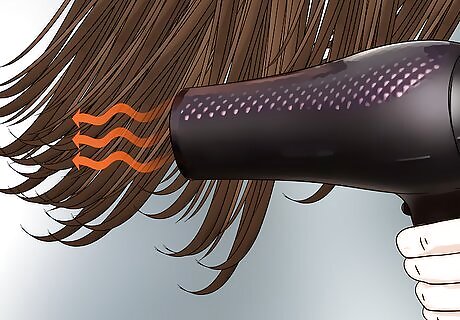
Dry your hair quickly. Rust is caused by the reaction between the fine iron particles and water. The faster you dry your hair after bathing, the less likely it is that you’ll get rust in it. Use a blow dryer to speed the drying process along.

















Comments
0 comment